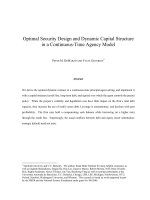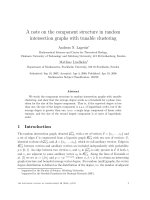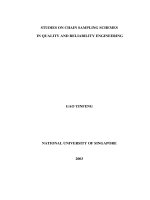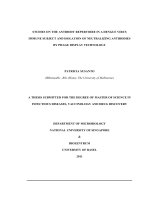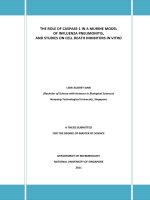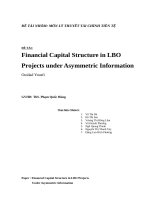Empirical studies on coroorate capital structure in viet nan
Bạn đang xem bản rút gọn của tài liệu. Xem và tải ngay bản đầy đủ của tài liệu tại đây (1.01 MB, 76 trang )
EMPIRICAL STUDIES ON CORPORATE
CAPITAL STRUCTURE IN VIETNAM
LINH, DOAN NGOC DUY1
Department of Business Administration
Graduate School of Soongsil University, Korea
ABSTRACT
The purpose of the study is to examine the influence of firm characteristics
(profitability, investment opportunity “market-to-book ratio”, tangibility, size,
growth) and industry effect to capital structure of stock companies in Vietnam. The
study uses OLS regression method to analyze a data set consisting of 522 nonfinancial companies listed in the two stock exchanges Ho Chi Minh Stock
Exchange (HSX) and Ha Noi Stock Exchange (HNX) during the period from 2008
to 2011.
The aggregate market-based leverage ratio in Vietnam is about 0.29. Despite
the differences in business environment and management, this ratio is consistent to
the statement from Frank and Goyal (2007) “Over the past half century the
1
Corresponding author.
Email address:
- 1 -
Electronic copy available at: />
aggregate market-based leverage ratio has been about 0.32”.
The empirical results show that profitability, tangibility, and growth are the
major three determinants to debt ratios. The strong negative correlation between
profitability and all debt ratios supports the prediction of the pecking order theory
and it is considered as a serious defect of the trade-off theory. Tangibility has a
strong positive correlation with long-term debt ratio but it has a negative
correlation with short-term debt ratio. This result is consistent with the maturity
mismatch principle “Firms tend to use long-term debt to finance fixed assets to
prevent maturity mismatch; consequently, firms with high fraction of tangibility are
expected to have high long-term debt ratio but low short-term debt ratio”. The
strong positive correlation between growth and all debt ratios is consistent to the
statement of Jensen and Meckling, 1976 “Debt disciplines managers and mitigates
agency problems to free cash flow since debt must be repaid to avoid bankruptcy”.
However, the fact that firms that have cash on hand actually issue debts is
considered a serious problem of the pecking order theory (Frank and Goyal, 2007).
As per the empirical results the corporate capital structure of the whole data is
dominated by short-term debt, but the corporate capital structure at industry level is
sometimes dominated by long-term debt. It is consistent with the result of Gilson
(1997) “Industry leverage is used as a proxy for target capital structure”. According
to Hovakimian et al. (2001), firms actively adjust their debt ratios towards the
industry average. And similar persistence at firm level is reported in Lemmon et al.
(2007). The differences of corporate capital structure at industry level and the
- 2 -
Electronic copy available at: />
similar persistence of capital structure at firm level reflect the role of industry
effect as the crucial determinant of the target debt ratios.
- 3 -
CHAPTER 1: Introduction
1.1 Introduction
To finance their business operations, companies have to use either equity capital or
debt capital. The combination of equity and debt, called the capital structure, is
affected by many factors and keeps changing.
Modigliani and Miller (1958; 1963) set a foundation for implementation of
empirical research and development of alternative theories on capital structure.
These theories have been tested through a series of empirical studies to identify
which determinants have a major role on capital structure decision. This study is
the first empirical test of the capital structure theories in the Vietnam market. Since
it is the first empirical work on the capital structure in Vietnam, this study
introduces capital structure theories and provides empirical evidences for managers
and investors of companies in Vietnam which help them to understand how and
which determinants affect their debt policy decisions at firm level and industry
level. As per Frank and Goyal (2007), industry median leverage, profitability,
tangibility, market-to-book ratio, size, and inflation are six core factors which
account for more than 27% of the variation in leverage. That is the reason why the
study examines the effect of firm characteristics (profitability, tangibility,
investment opportunity, size, and growth) on debt ratios at firm level and then
expanding into industry level in order to examine the industry effect. The empirical
results are reliable because they are based on the raw data of 552 firms listed in the
- 4 -
Stock Exchanges in the period from 2008 to 2011.
The study is organized as follows. Chapter 1, the study illustrates the capital
market in Vietnam and reviews the literature on capital structure. The study is then
divided into two essays (chapter 2 and chapter 3). Chapter 2, which examines the
effects of a firm’s characteristics, consists of four sections: section 1 develops
hypotheses between a firm’s characteristic factors and leverage; section 2 discusses
data collection and designs model; section 3 presents empirical results; and section
4 presents the conclusion of the chapter. Chapter 3, which examines the industry
effect, consists of four sections: section 1 summarizes industry groups in Vietnam;
section 2 designs model; section 3 presents empirical results; and section 4 presents
the conclusion of the chapter. Chapter 4 concludes the study.
1.2 The capital market in Vietnam
In 1986, Vietnam implemented “Doi Moi” policy. This policy set a big change in
the concept of an economy that transformed the command economy to a market
economy. The privatization program was the key issue in the process of economic
transformation at that time. In the process of economic transformation, the
government promoted private ownership and launched the privatization program
which transformed the State-Owned Enterprises (SOEs) to joint stocks companies.
There has been an impressive reduction in the number of SOEs from 12,000 SOEs
in 1991 to 1,200 SOEs in 2010 (IMF, 2010; WB, 2012). As a result, a lot of stock
companies were created in the market at that time, which set the foundation for the
- 5 -
development of an equity market in the future.
1.2.1
Bank lending channel
The Vietnam capital market is a bank-centered financial system. According to the
National Financial Supervisory Committee, up until 2009, 80% of the capital of the
national economy was bank loans (Nguyen, H., 2010). According to Manh Quan
Nguyen, deputy general director of HDBank, most of the capital in the bank is
short-term funds, while the demand from the market for longer term loans is
increasing rapidly (MHB, 2009). The capital market, which is overly dependent on
bank finance, reflects the lack of stable long-term financing channels and
underdevelopment of the capital market in Vietnam.
1.2.2
The equity market in Vietnam
The equity market has strongly developed since the establishment of the two stock
exchanges HSX and HNX, which were founded in 2000 and 2005 respectively.
From the beginning in 2000, there were only 5 companies with market
capitalization, accounting for 0.2% GDP listed in the equity market. Ten years later
in 2010, there were 600 companies with market capitalization of USD 35 billion,
accounting for 45% GDP, listed in the equity market.
The booming of the equity market has offered a long-term financing channel to
reduce the burden on the banking system. It has also offered an effective channel to
attract foreign investment capital.
- 6 -
1.2.3
The bond market in Vietnam
Despite its recently rapid development, the size of Vietnam’s bond market remains
very small, compared to many other emerging East Asian markets such as China,
South Korea, Singapore, Thailand, Malaysia and The Philippines. According to
Hoang Huy Ha, the chairman of the Vietnam Bond Association, the local bond
market now accounts for only 17% of GDP while that number in China, Thailand,
Singapore, and Malaysia is 53%, 58%, 74% and 82% respectively (Vietnam
Business Forum, 2010). Government bonds are the key instrument in the Vietnam
bond market, occupying the largest portion (86%) of the whole market. The
corporate bond occupies 10% and the municipal occupies 4% (Vietnam’s Ministry
of Finance, 2009, quoted in Vuong & Tran, 2010). Moreover, corporate bonds are
mainly a playing field of large and famous enterprises. The fact that most small and
medium enterprises (SMEs) are unable to access this long-term finance channel
results in a definitive increase in the number of enterprises which file for
bankruptcy (from 40,000 to 53,000 to 54,000 and to 61,000 in the four consecutive
years 2010, 2011, 2012, 2013 respectively).
Bolton and Freixas (2008) argue that bond financing, as a form of long-term
finance, does not expose firms to risks of bank runs and systemic crisis. While
bank-financed firms are fully exposed to risks of bank loans, bond-financed firms
are shielded from adverse effects of a financial crisis, and therefore are more likely
to survive. As a consequence, bond issuers in a financial crisis are more likely to
- 7 -
survive than non-issuers.
1.3 Literature
Capital structure can be defined as the mixture of a firm’s capital with debt and
equity and it has been one of the most argumentative subjects in corporate finance,
since the outstanding study of Modigliani and Miller in 1958 (Bevan and Danbolt,
2004). Many theories have been developed in the literature for examining
determinants of capital structure and they focus on which determinants are more
likely to have a major role on the leverage decisions.
How do firms finance their operations? And what factors influence their capital
structure choices? Weston (1955) raises the above questions and argues whether it
is possible to answer these questions. And Steward C. Myers (1984) starts the
paper “Capital Structure Puzzle” by asking the question, “How do firms choose
their capital structures?” then answering it, “We don't know”. In fact, it is still
debated over what the determinants of capital structure are and how they impact
capital structure decisions, even though there have been various studies conducted
on the subject.
As per Frank and Goyal (2007), taxes, bankruptcy costs, transaction costs,
adverse selection, and agency conflicts have all been advocated as major
explanations for the corporate use of debt financing. Myers (1984) describes the
“trade-off theory” as the hypothesis that firms balance tax savings from debt
against deadweight bankruptcy costs. He also describes the “pecking order theory”
- 8 -
as the hypothesis that due to adverse selection, firms first look to retained earnings,
then to debt, and only in extreme circumstances to equity for financing. However,
no currently available model appears capable of simultaneously accounting for all
of the stylized facts.
Over long periods of time, aggregate leverage is stationary (Frank and Goyal,
2007). Similar persistence at the firm level is reported in Lemmon et al. (2007).
The persistence in leverage ratios places important limits on theory. It means that a
satisfactory theory must account for why firms keep leverage stationary. In other
words, the theory must explain why the environment serves to maintain the
leverage despite a difference in management.
Over the past half century, the aggregate market-based leverage ratio has been
about 0.32. There have been surprisingly small fluctuations in this ratio from
decade to decade (Frank and Goyal, 2007). Following Myers (1984), it may seem
that the stability of aggregate leverage is consistent with the trade-off theory. In
fact, there is too much stability for the simple version of tax versus bankruptcy
theory. For most of the 1950s and the 1960s, the top corporate tax rate was roughly
50%. In the 1990s, it was around 35%. Despite this large difference in tax rates, the
market leverage ratio averaged 0.32 in both the 1950s and in the 1990s, while, in
the 1960s, it averaged 0.27. Have bankruptcy costs really fluctuated in just the right
manner to account for this evidence? It seems hard to imagine. This evidence,
while not a proof, is certainly a serious warning sign for the trade-off theory. The
remarkable stability of leverage ratios also poses a problem for the pecking order
- 9 -
theory. Leverage should fluctuate as the financing deficit ebbs and flows, according
to the standard pecking order theory. In order to account for this evidence,
something must be added to the basic pecking order theory (see Frank and Goyal,
2007).
Thus the standard versions of both the trade-off theory and the pecking order
theory appear to be inadequate. Both approaches need to be improved to account
for the known facts. Recently, proponents of the trade-off approach have focused
their efforts mainly on developing dynamic structural trade-off models. An
attractive feature of these models is that they try to provide a unified framework
that can simultaneously account for many facts. Examples include Leary and
Roberts (2007), Hennessy and Whited (2005), Ju et al. (2005), and Strebulaev
(2007). Proponents of the pecking order theory have focused recently on the
development of a satisfactory notion of “debt capacity” (see, Lemmon and Zender,
2004) and on more complex adverse selection models (see Halov and Heider,
2005).
1.3.1
Modigliani-Miller Theorem(1958)
Modigliani and Miller start by assuming that the firm has a particular set of
expected cash flows. When the firm chooses a certain proportion of debt and equity
to finance its assets, all that it does is to divide up the cash flows among investors.
Investors and firms are assumed to have equal access to financial markets, which
allows for homemade leverage. The investor can create any leverage that was
- 10 -
wanted but not offered, or the investor can get rid of any leverage that the firm took
on but was not wanted. As a result, the leverage of the firm has no effect on the
market value of the firm.
There are two fundamentally different types of capital structure irrelevance
propositions. The classic arbitrage-based irrelevance propositions provide settings
in which arbitrage by investors keeps the value of the firm independent of its
leverage. A second kind of capital structure irrelevance is associated with multiple
equilibria. In models of this kind, equilibrium conditions pin down the aggregate
amount of debt and equity in the market.
The 1958 paper stimulated serious research devoted to disproving irrelevance
as a matter of theory or as an empirical matter. This research has shown that the
Modigliani-Miller theorem fails under a variety of circumstances. The most
commonly used elements include consideration of taxes, transaction costs,
bankruptcy costs, agency conflicts, adverse selection, lack of separability between
financing and operations, time-varying financial market opportunities, and
investing client effects.
While the Modigliani-Miller theorem does not provide a realistic description of
how firms finance their operations, it provides a means of finding reasons why
financing may matter. Accordingly, it influenced the early development of both the
trade-off theory and the pecking order theory (see Frank and Goyal, 2007).
1.3.2
Trade-off Theory
- 11 -
Myers (1958) considers the “trade-off theory” to be the hypothesis that firms
balance tax savings from debt against deadweight bankruptcy costs. The trade-off
theory states that interest tax shield and cost of bankruptcy (financial distress) play
crucial roles in a firm’s leveraged ratio. This theory suggests that the total value of
a geared firm equals the value of the ungeared firm plus present value of the
interest tax shield minus the present value of financial cost (Berk and DeMarzo,
2007). Therefore, the firm looks for optimum debt ratio which offsets tax savings
benefits opposed to the cost of possible bankruptcy and agency conflict (Gajurel,
2005). According to Myers (1984), the key implication of the trade-off theory is
that leverage exhibits target adjustment so that deviations from the target are
gradually eliminated.
Financial distress has an important position in capital structure theories. Berk
and DeMarzo (2007, p. 509) define financial distress: “When a firm has trouble
meeting its debt obligations we say the firm is in financial distress.” When a firm
increases its proportion of debt to equity for financing its operations and future
investments, the probability of default on the debt will rise as well (Kraus and
Litzenberger, 1973). The cost arising from financial distress plays a crucial role on
the firm’s future decisions, such as investment policy, cuts in research and
development activities, as well as advertisement and educational expenditures
(Warner, 1977). All these decisions as an outcome of financial distress will affect a
firm’s value negatively and lead to decline in the firm’s value; therefore the wealth
of shareholders will decrease as well (Arnold, 2008).
- 12 -
There are two types of costs arising from financial distress: direct and indirect cost.
Direct costs are bankruptcy fees, administrative fees and legal costs (Warner, 1977).
Indirect costs arise from a firm’s decision-making due to financial distress. These
are, as mentioned above, changes in investment policy, such as postponing future
positive NPV investments or totally discarding investment opportunity, a decrease
in staff educational expenditures, reducing research and development, and reducing
marketing activities (Arnold, 2008).
According to the trade-off theory, companies that make high profits are more
likely to have higher leverage and more taxable income to shield (Barclay and
Smith, 2005). However, the Rajan and Zingales (1995) study shows that this theory
fails in some cases to illuminate why profitable firms have low debt ratio. Also
Bevan and Danbolt (2002) suggest that the trade-off theory has some shortcomings
and limitations. In addition to these, the empirical studies of Kester (1986), the
study of Titman and Wessels (1988) support that there is a strong inverse
correlation between profitability and debt ratios in capital structure. As a result, due
to shortcomings and flaws of the trade-off theory, the theory is not adequate when
determining the ideal capital structure.
1.3.2.1 Static trade-off theory
A particularly important problem for the standard static trade-off theory is provided
by the historical record. In the static trade-off theory, it is the desire to limit tax
payments that motivate a firm to use debt financing (see Modigliani and Miller,
- 13 -
1963). It is actually quite difficult to match the observed leverage ratios in
particular decades with the corporate tax rates in those decades. Even more
remarkable, corporate income taxes are only about a century old. Debt financing
was common long before the introduction of corporate income taxes. Thus, we
know that taxes do not provide a complete justification for the use of debt
financing.
1.3.2.2 Dynamic trade-off theory
In a dynamic model, the correct financing decision typically depends on the
financing margin that the firm anticipates in the next period. Some firms expect to
pay out funds in the next period, while others expect to raise funds. If funds are to
be raised, they may take the form of debt or equity. More generally, a firm
undertakes a combination of these actions.
Given that the firm is profitable, its investment opportunities are likely to be
better than those of its shareholders. This may lead to situations when it is better
for a firm to retain funds even though it faces a higher tax rate than do its
shareholders. Paying out money causes shareholders to pay taxes. With taxes, such
circular financing can be expensive. Thus, distributing funds and then raising new
equity subsequently imposes a tax liability on shareholders that could have been
avoided had the firm retained the funds. Hence, taxes can directly motivate firms to
retain earnings. Money paid in to the firm is not taxed, but money paid out is taxed.
For reasonable parameter values, Stiglitz's basic result is that it pays to finance as
- 14 -
much investment as possible through retained earnings and to finance the excess of
investment over retained earnings with debt. The observed leverage ratio is thus a
fortuitous outcome of the profit and investment history of the firm (Stiglitz, 1973,
page 32). In other words, the solution is essentially what we might now call the
pecking order.
1.3.3
Pecking order theory
Myers (1984) describes “the pecking order theory” as the hypothesis that due to
adverse selection, firms first look to retained earnings, then to debt, and only in
extreme circumstances to equity for financing (see Frank and Goyal, 2007). The
pecking order theory (Myers and Majluf, 1984; and Myers, 1984) is based on the
idea of asymmetric information between managers and investors. Managers know
more about the true value of the firm and the firm’s threats than less informed
outside investors. To avoid the underinvestment problem, managers will seek to
finance a new project using a security that is not undervalued by the market, such
as internal funds or riskless debt. Therefore, this affects the choice between internal
and external financing. The pecking order theory is able to explain why firms tend
to depend on internal sources of funds and prefer debt to equity if external
financing is required. Thus, a firm’s leverage is not driven by the trade-off theory,
but it is simply the cumulative results of the firm’s attempts to mitigate information
asymmetry.
Myers and Majluf (1984) proposed in the pecking order theory that firms
- 15 -
would prefer retained earnings as a primary source of internal financing. If internal
financing does not meet the requirements, then firms prefer external financing by
issuing securities. According to Myers (1984), if the firm is in need of using
external finance, it chooses first the safest security (debt market) to issue rather
than convertible bonds. As a last choice, the firm falls back on the equity market
and issues external equity.
The firm that does not have enough available internal finance would either use
equity or debt issue to finance future positive NPV investments. According to
Myers and Majluf (1984), issuing external equity gives a bad signal to the market
that supporting equity is overrated. Nevertheless issuing debt sends a signal that the
supporting stock is underestimated. This conflict leads to an interaction between
investments and financing decisions (Gajurel, 2005, p. 19). The main prediction of
the pecking order theory is that firms with high information asymmetry rely more
on issuing debt to finance their external financing needs, given that the financial
distress cost is low. Short–term debt, which is less sensitive to the information
asymmetry problem relative to long-term debt (Flannery (1986)), should constitute
a higher proportion of the debt financing if the information asymmetry is uniformly
distributed over time. Under such assumption, we expect to find a higher impact of
information asymmetry on the proportion of short-term debt financing.
1.3.3.1 Financial deficit
Changes in debt have played an important role in assessing the pecking order
- 16 -
theory. This is because the financing deficit is supposed to drive debt according to
this theory. Shyam-Sunder and Myers (1999) examine debt responses to short-term
variation in investment and earnings. The theory predicts that when investments
exceed earnings, debt grows, and when earnings exceed investments, debt falls.
Tests of the pecking order theory define financing deficit as investments plus
change in working capital plus dividends less internal cash flow. Frank and Goyal
(2003) examine the broad applicability of the pecking order theory. Their evidence
based on a large cross-section of U.S. publicly traded firms over long time periods,
shows that external financing is heavily used by some firms. On average, net equity
issues track the financing deficit more closely than do net debt issues. These facts
do not match the claims of the pecking order theory. The greatest support for
pecking order is found among large firms, which might be expected to face the
least severe adverse selection problem since they receive much better coverage by
equity analysts. Even here, the support for pecking order is declining over time.
They conclude that the pecking order theory does not explain broad patterns in the
data.
1.3.3.2 Debt capacity
Firms adjust their debt frequently. Financing deficit plays a role in these decisions.
According to Lemmon and Zender (2004), the idea of debt capacity is important in
understanding the rejections of the pecking order theory. Consideration of debt
capacity suggests that, when unconstrained by debt capacity, firms issue debt; yet
- 17 -
when constrained, they issue equity. These tests require a workable definition of
debt capacity. If debt capacity is defined as the point when adding more leverage
reduces firm value, then debt capacity is similar to the concept of target leverage as
defined by the trade-off theory of capital structure. Thus, the fact that firms use
debt to fill the financing deficit when they are below their debt capacity may not
sharply distinguish two theories. Lemmon and Zender explain the concept of debt
capacity by focusing on firms with rated debt. They argue that firms with debt
ratings are unconstrained by debt capacity while firms without debt ratings are
constrained. Lemmon and Zender find, as expected, that the coefficient on
financing deficit in net debt regressions is significantly larger for firms with rated
debt, and it is smaller for firms with no debt rating. They also show that firms with
no debt rating are small, high-growth firms, and that they use equity to finance
their deficits. These results are consistent with those in Fama and French (2002)
and Frank and Goyal (2003). The interpretation, however, is different. While Frank
and Goyal suggest that these firms face more asymmetric information problems
and thus the pecking order predicts that they should issue equity. However,
Lemmon and Zender suggest that these firms are debt capacity constrained and
therefore issue equity.
Another attempt to reconcile the evidence in Frank and Goyal (2003) with the
predictions of adverse selection arguments is described in Halov and Heider (2005).
The paper argues that when there is greater asymmetric information about risk,
debt has a more severe adverse selection problem and firms would only issue
- 18 -
equity. To test these arguments, Halov and Heider use asset volatility as a proxy for
asymmetric information about risk, and divide firms into deciles based on asset
volatility. They show that as asset volatility increases, firms use more equity to
finance their deficits. The interpretation of these results rests on the assumption
that differences in asset volatility deciles capture differences in asymmetric
information regarding cash flow variance. The mean of the distribution is common
knowledge. Thus, small, young, high-growth firms will issue equity to finance their
deficits if these firms have more asymmetric information about risk and less
asymmetric information about value.
1.3.3.3 The modified pecking order theory
In the pecking order theory C. Meyers (1984), firms prefer internal to external
funds and debt to equity if external funds are needed. Thus the debt ratio reflects
the cumulative requirement for external financing. Pecking order behavior follows
from simple asymmetric information models
In the modified pecking order story, observed debt ratios will reflect the
cumulative requirement for external financing, a requirement cumulated over an
extended period. For example, think of an unusually profitable firm in an industry
generating relatively slow growth. That firm will end up with an unusually low
debt ratio compared to its industry's average, and it won't do much of anything
about it. It won't go out of its way to issue debt and retire equity to achieve a more
normal debt ratio. An unprofitable firm in the same industry will end up with a
- 19 -
relatively high debt ratio. If it is high enough to create significant costs of financial
distress, the firm may rebalance its capital structure by issuing equity. On the other
hand, it may not. The same asymmetric information problems which sometimes
prevent a firm from issuing stock to finance real investment will sometimes also
block issuing stock to retire debt. If this story is right, average debt ratios will vary
from industry to industry, because asset risk, asset type, and requirements for
external funds also vary by industry. But a long-run industry average will not be a
meaningful target for individual firms in that industry.
A particularly important problem for the standard version of the pecking order
theory concerns the use of equity financing. Firms issue too much equity (Frank
and Goyal, 2003) and at the wrong times (Fama and French, 2005; Leary and
Roberts, 2007). In the pecking order, it is the financing deficit that drives debt
issues. Empirically, however, other factors appear to be more important (Frank and
Goyal, 2003).
The pecking order theory suggests that there is no exact target level of leverage
and interest tax shield and financial distress are considered as less effective factors
when determining capital structure decisions (Myers, 2001). Also Meyers further
advocates that the trade-off theory does not differentiate finance equities as
external and internal, and he states that there is a positive correlation between
profitability and debt ratio. Nevertheless, the pecking order theory advocates a
negatively correlated relationship, as Myers and Majluf (1984) suggest less
profitable firms are more like to borrow more debt to finance future positive NPV
- 20 -
investments; therefore the firm will raise its profitability. In addition to this, the
studies of Ozkan (2001), Kester (1986) and Titman and Wessels (1988) support an
inverse relationship between leverage and profitability. As a result, the pecking
order theory is much more accurate in order to explain reverse relationship of
profitability and debt ratios rather than the trade-off theory.
1.3.4
Agency cost
Jensen and Meckling (1976) defined agency costs as examining conflicts and
relationships between the agent (corporate managers) and principals (shareholders).
The opposed interests of principals and agents, along with the separation of
management and ownership in a firm, cause these conflicts. For instance, managers
may be interested in taking negative NPV projects or making unnecessary
acquisitions by paying too much to increase the size and reputation of the firm
instead of maximizing the wealth of shareholders. The explanation behind this is
that the agents are more likely to run and control bigger firms than smaller ones.
Hence the managers will receive higher salaries and remuneration packages as a
result of the increasing size of the firm (Berk and DeMarzo, 2007). In conclusion,
managers may tend to operate the firm consistent with their interests rather than
taking into consideration increasing the firm’s value and wealth of shareholders.
Harris and Raviv (1991) and Jensen (1986) describe two types of conflicts, the
agency cost of equity and the agency cost of debt. The agency cost of equity, as
mentioned above, is between shareholders and managers, and small firms generally
- 21 -
do not suffer from this cost since they are mostly operated by owners (Easterbrook,
1984). This cost emerges from the management board’s different interests, which
do not always correspond to maximizing stockholder wealth. The agency cost of
debt is between equity holders and debt holders and this conflict arises from risk
shifting, which means transferring risk from debt holders to equity holders by
making risky investments with debt (Jensen, 1986).
Jensen (1986) also states that a firm, which has high levels of excess cash, is
more likely to experience agency cost. When excess cash is reduced and debt is
increased, it would limit the availability of money for future investments and
spending. Hence managers tend to manage firms more attentively in order not to
face financial distress, and this decreases the possibility of experiencing agency
cost. According to the Harris and Raviv (1991) study, leverage is used as a tool for
providing motivation and discipline for management and minimizing agency cost.
In conclusion, Harris and Raviv (1991) further state that there is a positive
relationship between leverage and free cash flow, as well as company value and
liquidity. The “agency” perspective is that debt disciplines managers and mitigates
agency problems of free cash flow since debt must be repaid to avoid bankruptcy
(Jensen and Meckling, 1976; Jensen, 1986). Although debt mitigates shareholdermanager conflicts, it exacerbates shareholder-debtholder conflicts (Myers, 1977).
1.3.5
Market timing hypothesis
It is well known that firms are more likely to issue equity when their market values
- 22 -
are high, relative to book and past market values, and to repurchase equity when
their market values are low. We document that the resulting effects on capital
structure are very persistent. As a consequence, current capital structure is strongly
related to past market values. The results suggest that capital structure is the
cumulative outcome of past attempts to time the equity market (Baker and Wurlger,
2002).
If firms time their equity issue (reduction) with favorable market conditions,
we expect to find such a behavior to affect the proportion of debt financing
(reduction) relative to the financing deficit (surplus). Lucas and MacDonald (1990)
model predicts that managers with superior private information will delay equity
issue until their stock prices rise. Korajczyk, Lucas, and MacDonald (1990) find
evidence supporting this prediction, as firms’ equity issuance clusters following
stock prices run up. Hovakimian, Opler, and Titman (2001) find evidence that stock
prices run up (decline) play a significant role in the firms’ choice of equity issuance
and repurchase decision. Baker and Wurlger (2002) also find supporting evidence
for the market timing hypothesis. We use the ratio of stock price (St) in the current
period relative to the previous one to test the market-timing hypothesis. If firms
time their equity issue (reduction) with favorable market conditions, we expect to
find a negative sign of St for the financing deficit group and a positive sign for the
financing surplus group.
1.3.6
Industry effect
- 23 -
Industry differences in leverage ratios have several possible meanings. One
interpretation is that managers perhaps use industry median leverage as a
benchmark as they contemplate their own firm’s leverage. Thus, industry median
leverage is often used as a proxy for target capital structure (Gilson,1997).
Hovakimian et al. (2001) provide evidence consistent with firms actively adjusting
their debt ratios towards the industry average.
Another interpretation is that industry effects reflect a set of correlated, but
otherwise omitted factors. Firms in an industry face common forces that affect their
financing decisions. These could reflect product market interactions or the nature
of competition. These could also reflect industry heterogeneity in the types of
assets, business risk, technology, or regulation. Industry factors do not have a
unique interpretation.
Tradeoff theory predicts that higher industry median growth should result in
less debt, while higher industry median leverage should result in more debt.
Regulated firms have stable cash flows and lower expected costs of financial
distress. Thus, regulated firms should have more debt. On the other hand, managers
have less discretion in regulated firms which reduces the severity of shareholdermanager conflicts, and makes debt less desirable from a control perspective.
Tradeoff theory makes ambiguous prediction concerning the effect of regulation on
leverage.
Under a pure pecking order perspective, the industry should only matter to the
extent that it serves as a proxy for the firm’s financing deficit. Under the market
- 24 -
timing theory, the industry should matter only if valuations are correlated across
firms in an industry. Firms that compete in certain industries, in which the median
firm has high leverage, tend to have high leverage.
Over long periods of time, aggregate leverage is stationary (Frank and Goyal,
2007). Similar persistence at the firm level is reported in Lemmon et al. (2007).
The persistence in leverage ratios places important limits on theory. It means that a
satisfactory theory must account for why firms keep leverage stationary. In other
words, the theory must explain why the environment serves to maintain the
leverage despite management difference.
CHAPTER 2: Firm Characteristics and Leverage
- 25 -
